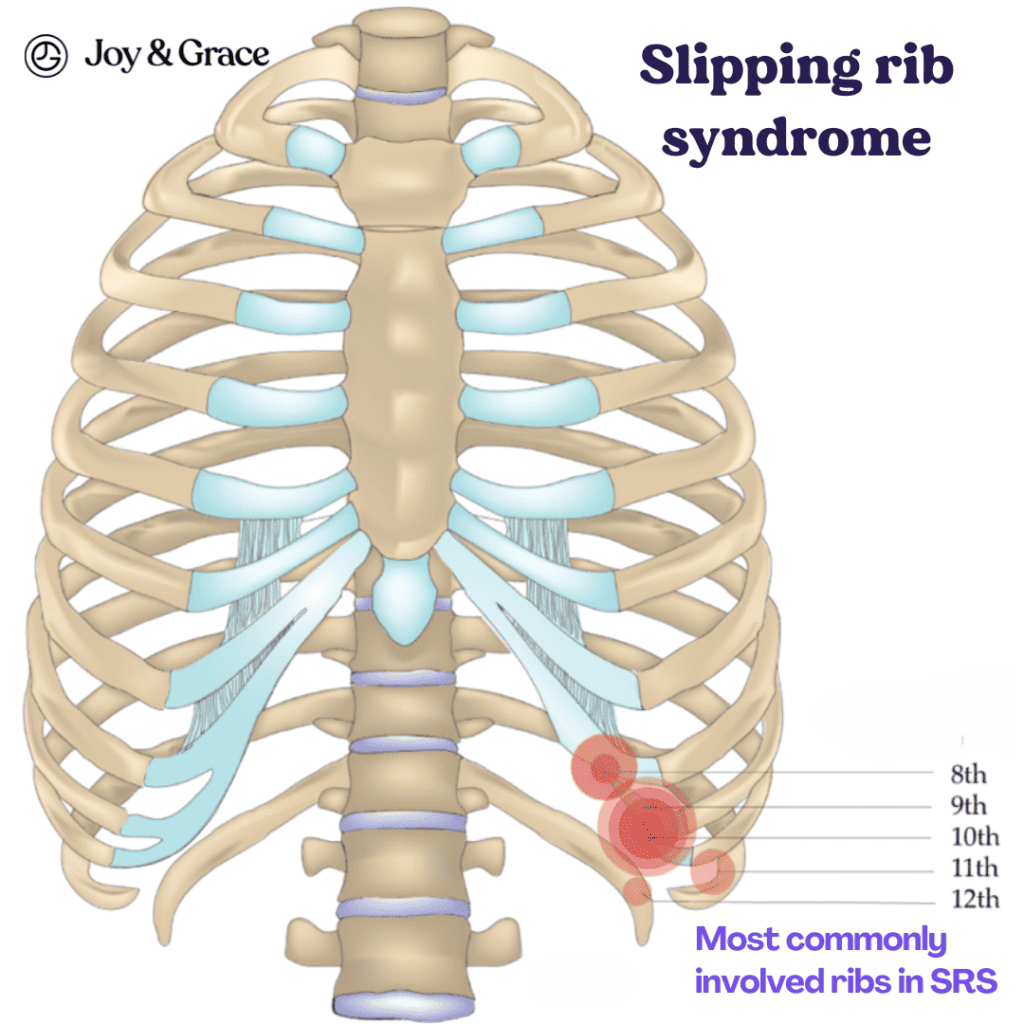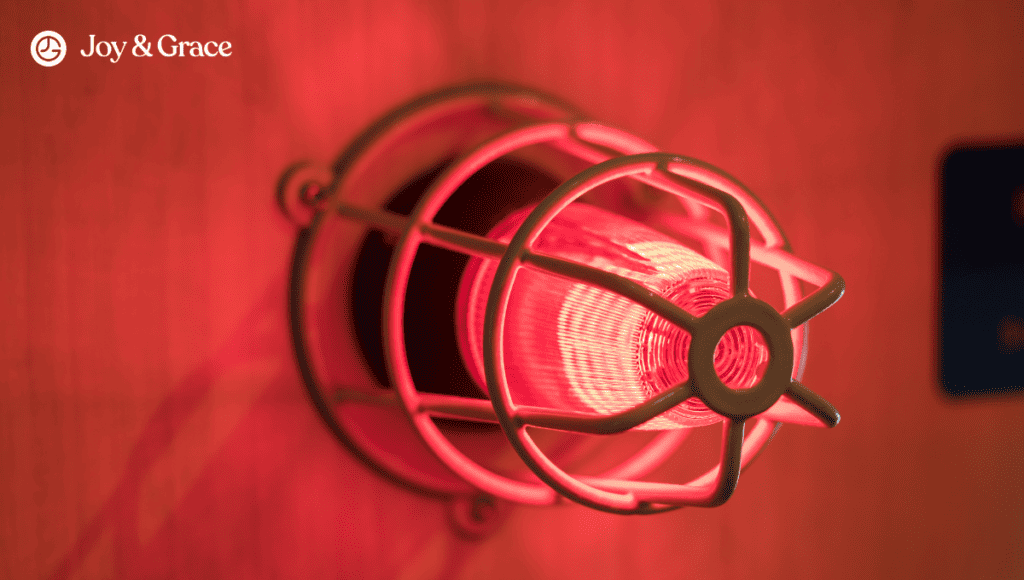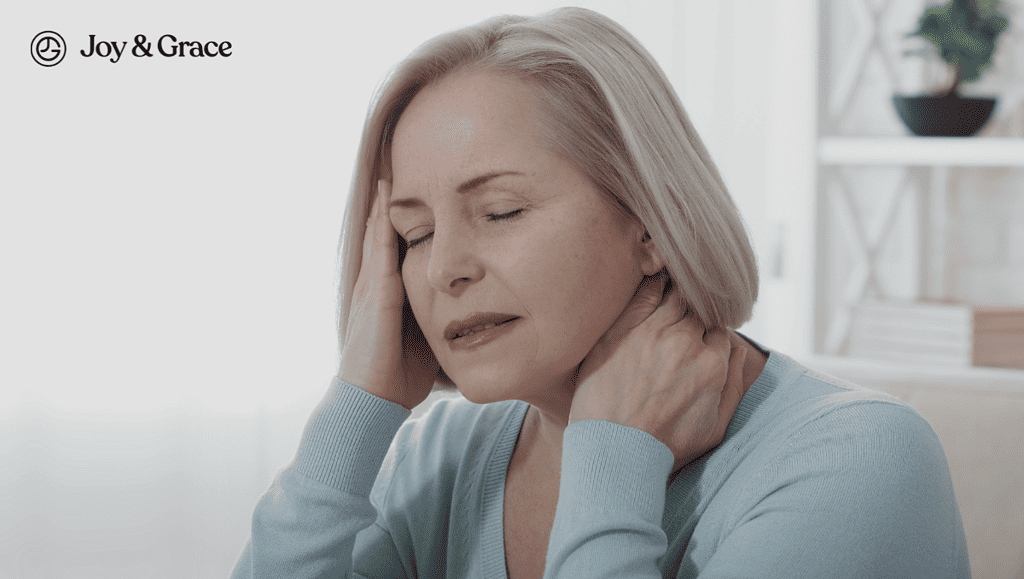Have you ever found yourself in a warm, welcoming embrace, only to struggle with an ache in your ribs that travels up to your shoulders? The crippling shoulder and rib pain can bring life to a standstill, leaving you in a world of discomfort far from normal.
At Joy & Grace, we understand your pain - be it shoulder, neck, or rib pain. In this blog, we hope to shed some light on why you may be experiencing this discomfort and provide guidance in finding relief. So if you’re ready to reclaim a pain-free life, let’s dive in!
Why Do I Have Pain In My Ribs And Shoulder?
When you experience pain in your ribs and shoulder, it can be due to several reasons. Minor causes are usually the most common culprits, and they include things like:
- Muscle strains. Overexertion or sudden movements can lead to strains or sprains in the muscles around the ribs and shoulders. Try to remember if you’ve made any such movement recently.
- Poor posture. Poor posture, especially during computer use, can lead to various issues. For instance, laying on your armrest too much and typing in a non-ergonomic manner can cause both rib and shoulder joint pain.
- Troubles during sleep. Bad sleeping habits and positions can also contribute to rib and shoulder pain. Sleeping in awkward positions, such as on your stomach with your arms extended overhead, can strain the muscles around the ribcage and shoulders. Additionally, sleeping on one side without proper support for the neck and shoulder can lead to misalignment and discomfort.
Less commonly, there are more serious causes of rib and shoulder pain, such as:
Fractured Ribs
Fractured ribs can cause sharp pain in the ribcage area. Depending on the location of the fracture, the pain may also be felt in the shoulder region. The pain is usually localized and may be worsened by:
- Breathing
- Coughing
- Laughing (yes, you heard that right)
- Moving
Fractured ribs are commonly caused by trauma to the chest, such as:
- A fall
- Sports injury
- Car accident
If you don’t have severe pain or no history of trauma to the chest, it’s unlikely your pain is coming from a fractured rib.
Cervical Ribs
Cervical ribs are extra ribs that develop above the first rib. A cervical rib is rare and occurs in approximately 0.2% to 0.5% (1 in 200 to 500) of the population. They are usually present at birth. They may cause compression or irritation of nearby nerves and blood vessels, leading to neck, shoulder, and arm pain.
In one case, a 28-year-old woman suffered from neck and right shoulder pain for three years. The pain radiated to her hand and worsened at night and when she moved her right arm.
Upon further investigation, it was found that she had cervical ribs on both sides. The right cervical rib was longer than the left and caused thoracic outlet syndrome (TOS). We’ll touch more on TOS later.
Costochondritis
Costochondritis is inflammation of the cartilage connecting the ribs to the breastbone (sternum). It can cause sharp chest pain, which may be mistaken for heart-related issues. The pain can radiate to the shoulder and is often worsened by deep breaths, coughing, or physical activity. Costochondritis is usually a result of injury, strain, or certain medical conditions.
Heart Problems
Chest pain from heart problems may be mistaken as rib pain. A heart attack or angina (chest pain due to reduced blood flow to the heart muscle) can cause referred pain to the left shoulder and arm.
This happens because the heart's nerves also share pathways with those supplying the shoulder area.
However, it’s important to note that heart problems rarely present solely with shoulder and rib pain.
Other symptoms may accompany heart-related pain:
- Extreme fatigue
- Shortness of breath
- Sweating
- Nausea
- Pain that radiates to the back and jaw
- Dizziness
- Lung Problems
Lung issues like pneumonia can lead to rib and shoulder pain. The pain may arise from pleurisy, the inflammation of the pleura (lining of the lungs), or irritation of the surrounding structures. Breathing may exacerbate the pain.
Pancoast Tumor
A Pancoast tumor, or a superior sulcus tumor, is a specific type of lung cancer. It forms in the apex or rounded uppermost part of the lung located above the first rib.
Because of its closeness to the first rib and possible involvement of the surrounding nerves, a Pancoast tumor can cause shoulder and rib pain. Shoulder pain is the most common symptom and is present in 96% of patients. The pain can also radiate to the neck, armpit, shoulder blades, arms, and hand.
It’s important to note that Pancoast tumors come with many symptoms other than shoulder and rib pain. These include:
- Horner's syndrome
- Drooping eyelid
- Small pupil
- Lack of sweating on one side of the face
- Weakness and shrinking of hand muscles
- In later stages, coughing up blood and shortness of breath
- Digestive Issues
Various digestive problems can cause referred pain in the rib and shoulder area. The pain may be worse when eating or lying down. These include conditions like:
- Gallstones. Gallstones also present with intense pain on the right side of the abdomen, under the ribcage. The pain can radiate to the right shoulder or between the shoulder blades. Additional symptoms of gallstones can include nausea, vomiting, bloating, feeling of fullness, and intolerance to fatty foods.
- Gastroesophageal reflux disease (GERD). The main symptoms of GERD are heartburn, a burning sensation in the chest, and acid regurgitation.
- Pancreatitis. Pancreatitis causes pain in the upper abdomen that may radiate to the back and shoulder area. Other symptoms of pancreatitis include nausea, vomiting, fever, rapid pulse, and abdominal tenderness.
Tietze Syndrome
Tietze syndrome, or costochondral junction syndrome, is a rare inflammatory condition. It’s characterized by swelling and tenderness at the costochondral junctions - where the ribs meet the breastbone (sternum).
Tietze syndrome can cause pain and discomfort in the chest, specifically near the upper ribs. The affected area may swell and be tender to the touch. Chest or upper body movements may aggravate the pain. This pain can sometimes extend to the shoulder region due to the proximity of the affected rib joints to the shoulder.
Tietze syndrome is often confused with costochondritis. The main difference between the two conditions is the swelling present in Tietze syndrome. The swelling may persist even when the pain is gone.
What Is The Connection Between My Shoulders And Ribs?
The connection between the ribs and shoulders lies in the complex network of muscles, ligaments, and nerves in the upper body. The ribs and shoulders are functionally and anatomically interconnected. This is why you can sometimes feel rib and shoulder pain at the same time or experience referred pain between these areas.
Some of the mechanisms that cause shoulder and rib pain include:
- Muscular Connections
The chest, back, and shoulders muscles work together to support various movements and functions. An injury or strain in one area can affect the surrounding muscles. This can lead to pain that can be felt in both the rib and shoulder regions.
- Nervous System Overlap
The nervous system plays a crucial role in transmitting pain signals. The nerves that supply sensation to the ribcage and the shoulder share some pathways. These nerve connections are responsible for referred pain between these areas.
- Breathing Mechanism
The ribcage is essential for breathing. When you breathe, the ribs expand and contract to accommodate air into the lungs. Injuries to the ribs can affect breathing, leading to the use of accessory breathing muscles. The altered breathing can result in pain felt in both the rib and shoulder regions.
- Postural Changes
Pain in one body area can cause you to change your posture to minimize discomfort. For instance, if you have rib pain, you might alter your posture or shoulder position to avoid stressing the injured ribs. This compensation can lead to shoulder pain as well.
Overall, the complex interplay between the upper body's muscles, nerves, and movement patterns can lead to rib and shoulder pain.
Why Do My Left Ribs And Shoulder Hurt?
Your left ribs and shoulder may hurt due to the conditions mentioned above. However, pain in the left ribs and shoulder may sometimes be a clinical sign, called the Kehr’s sign.
Kehr's sign is a pain in the left shoulder that occurs when there is irritation or inflammation in the abdomen, particularly on the left side. The Kehr’s sign is a classic finding in patients with a ruptured spleen.
A traumatic injury or certain infections can cause the spleen to rupture. This leads to internal bleeding and irritation in the abdomen. This can also cause pain and tenderness behind your left ribs.
When there is irritation in the abdomen, the shared nerve pathways can cause pain to be referred from the abdomen to the left shoulder. So, pain that originates in the abdomen can "travel" along these nerve pathways and be felt in the left shoulder, leading to left shoulder pain.
Can Bruised Ribs Cause Shoulder Pain?
Yes, bruised ribs can indeed cause shoulder pain. A rib bruise, known medically as a rib contusion, is an injury to the rib that causes pain and discomfort in the affected area.
While we found no studies that link shoulder pain and bruised ribs together, it may be possible for referred pain to occur due to the connections we mentioned earlier:
- Muscular Connections
- Nervous System Overlap
- Breathing Mechanism, and
- Postural Changes
Can Fractured Ribs Cause Shoulder Pain?
Yes, fractured ribs can indeed cause shoulder pain. In fact, according to one study, a first rib stress fracture should be considered in overhead athletes suffering from shoulder pain.
Can A Dislocated Rib Cause Shoulder Blade Pain?
Yes, a dislocated rib can cause shoulder blade pain. When a rib becomes dislocated, it has moved out of its normal position, where it connects with the spine or the sternum (breastbone). This displacement can lead to pain and discomfort in the rib area. The pain can also travel to surrounding structures, including the shoulder blade.
A dislocated or subluxated rib is also termed a “dysfunctional rib.”
How Does A Dysfunctional First Rib Contribute To Shoulder Pain?
The ribs commonly associated with shoulder pain are the first ribs. The first rib is located at the base of the neck and serves as an attachment point for several important muscles and ligaments.
The thoracic outlet is a narrow space between the collarbone and the first rib. Nerves, blood vessels, and muscles pass through this space from the neck and chest to the arm. When the first rib becomes dysfunctional or moves out of its normal position, it can compress or irritate these structures. This can lead to various symptoms, including shoulder and neck pain.
Here's how it happens:
Compression of Nerves
The nerves passing through the thoracic outlet, including the brachial plexus, can get pinched between the first rib. This compression can cause:
- Pain
- Tingling
- Numbness
These symptoms can radiate from the shoulder down to the arm.
Vascular Compression
The dysfunctional first rib can also compress the blood vessels. It commonly involves the subclavian artery and vein. This can decrease blood flow to the arm and shoulder, leading to symptoms like coldness, discoloration, and swelling.
Muscle Involvement
The muscles around the thoracic outlet can become tight. This can worsen the compression of nerves and blood vessels. The resulting muscle tension can also contribute to shoulder pain and stiffness.
Poor Posture
A dysfunctional first rib can also affect the alignment and mechanics of the shoulder girdle. This can lead to muscle imbalances and shoulder pain.
Can Slipping Rib Syndrome Cause Shoulder Pain?

We found no studies that suggest slipping rib syndrome can cause shoulder pain.
However, it may be possible through a mechanism known as referred pain.
Slipping rib syndrome, or rib tip syndrome, is characterized by pain and discomfort in the chest or upper abdomen. It occurs when one or more lower ribs become hypermobile or dislocated. This can lead to irritation and compression of the surrounding nerves and tissues.
The condition most commonly affects the eighth, ninth, or tenth ribs, which are also called “the floating” ribs. They are floating ribs since they’re not attached directly to your breastbone but connected to the spine through cartilage. When the cartilage connecting these ribs to the sternum becomes weak or injured, the ribs can slip out of place.
Symptoms of slipping rib syndrome may include:
- Intermittent or constant sharp, stabbing pain in the chest or upper abdominal area.
- Tenderness and sensitivity around the affected rib(s).
- Pain that worsens with movement, deep breathing, coughing, or sneezing.
- The sensation of a "popping" or "clicking" in the chest.
- Pain that may radiate to the back
The exact cause of slipping rib syndrome is not always clear. It can result from various factors, including:
- Trauma or injury to the chest area
- Repetitive strain
- Activities that involve frequent twisting or bending of the torso
What Helps With Shoulder And Rib Pain?
When it comes to shoulder and rib pain, several self-care measures and lifestyle adjustments may provide some relief. Here are some potential options to consider:
- Rest and Avoid Strain
Give your shoulders and ribs ample time to rest. Avoid activities that may worsen the pain, such as lifting heavy objects. Overusing the affected areas can delay the healing process.
- Improve your posture
Be mindful of your posture throughout the day, especially during prolonged sitting or computer work. Maintaining good posture can reduce stress on the shoulders and ribs.
- Supportive Pillows
If you experience discomfort while sleeping, consider using pillows to support your shoulders. It’s also important to maintain a comfortable sleep position.
Applying an ice pack to the painful area for 15-20 minutes several times daily can help reduce inflammation. After the initial acute phase, you may find relief through heat therapy, such as using a warm compress or bath.
- Pain Relief Medication
Over-the-counter pain relievers may temporarily relieve mild to moderate pain. These include drugs like acetaminophen and ibuprofen. However, following the recommended dosage is essential.
- Gentle Stretching and Exercises
Doing gentle shoulder stretches and exercises recommended by a physiotherapist can help improve flexibility and strength. Over time, these exercises may help minimize discomfort.
- Breathing Techniques
Certain breathing exercises can help promote proper breathing patterns. This can lessen the use of your accessory muscles.
Everyone's body is unique. What works for one person may not work for you. Consulting a healthcare professional is crucial to determine the underlying cause of your pain and receive personalized advice and treatment.
How Do Doctors Fix A Dysfunctional Rib?

The specific treatment will depend on the underlying cause and severity of the condition. Here are some common approaches doctors may use:
- Manipulation or Mobilization
A chiropractor or osteopathic physician may use gentle manual manipulation or mobilization techniques to help realign the rib and surrounding tissues for specific rib dysfunctions.
- Physical Therapy
In some cases, a physical therapist may assist in providing exercises and therapies that aim to improve rib movement and reduce pain.
- Pain Management
Pain relief methods such as local anesthetic injections or nerve blocks may temporarily manage severe pain.
- Bracing or Taping
A doctor may recommend using a rib belt or taping in certain situations. These devices help to support and stabilize the affected area during the healing process.
- Surgery
In rare cases, surgery might be necessary for severe rib fractures or cervical ribs.
When Should I Be Concerned About Rib And Shoulder Pain?

Here are some situations where you should seek medical attention for rib and shoulder pain:
Severe or sudden onset of pain
Sudden or intense pain in your ribs and shoulders without any apparent cause may indicate a more serious condition. Seek medical attention right away.
Accompanied by breathing difficulties
If the pain in your ribs or shoulders is associated with difficulty breathing, this could be a sign of a serious respiratory or cardiac issue. If you experience these symptoms, seek medical attention immediately.
Injury or trauma
A recent injury or trauma to your chest, ribs, or shoulder requires immediate medical attention. Getting medical attention to rule out fractures, dislocations, or other injuries is essential.
Persistent or worsening pain
If the pain persists for an extended period or worsens over time, it could indicate an underlying medical condition.
Pain with other symptoms
Seek medical attention if you experience additional symptoms like:
- Fever
- Chills
- Numbness
- Weakness
- Tingling
- Loss of consciousness
History of cancer or other medical conditions
If you have a history of:
- Heart Problems
- Lung Disease
- Cancer
- Arthritis
It's crucial to seek medical advice when experiencing new pain symptoms.
Radiating pain
Pain that radiates from the ribs or shoulders to other areas might indicate nerve compression or other issue. Watch out for pain radiating to the back, abdomen, or arms.
Pain interfering with daily activities
If the pain is severe enough to disrupt your daily activities or sleep, it's essential to have it assessed by a healthcare professional.
Takeaway
Shoulder and rib pain can stem from various causes. They range from minor muscle strains to more serious conditions like fractured ribs.
While minor strains can be relieved by self-care and conservative management, persistent and severe pain may require medical attention. Prompt medical attention is essential to address the underlying issue and find relief.















